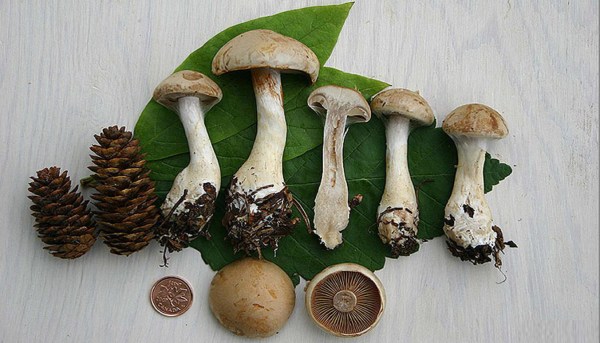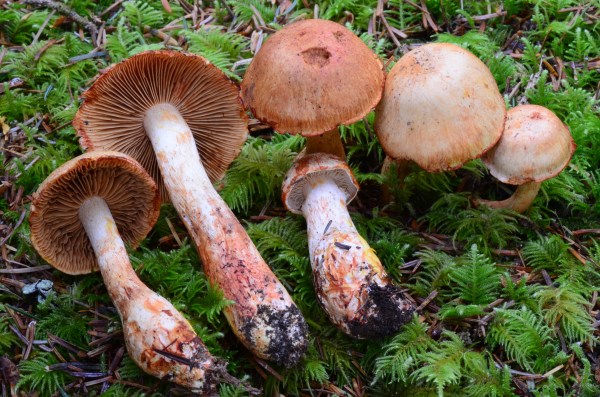Cortinarius subfoetens / Phlegmacium subfoetens is a relatively widespread species in Phlegmacium section Glaucopodes. It has very pale lilac young gills and a variable yellow-brown to greenish-brown cap with in-rolled margin, and bulbous base.
Cortinarius clintonianus
In young state, Cortinarius clintonianus should be clearly recognizable as an Anomali - it has typical pallid brownish colors on the dry cap and lilac young gills and upper stipe. However, photographed collections show that the lilac phase is not always visible, or may be transient. Gills of young specimens may appear more pallid, greyish or even clay colored.
Cortinarius comptulus
Cortinarius comptulus M.M. Moser, Nova Hedwigia 14: 514 (1968) [MB#329015] A Cortinarius in Telamonia, section Rubricosi. Described from Europe by Moser, it is known from Alaska and Oregon, and likely occurs elsewhere in the Pacific Northwest. Copyright Noah Siegel: NS1830
Phlegmacium spadicellum =Cortinarius rufolatus / Phlegmacium rufolatum
A subtantial, buff-capped Cortinarius with lilac gills, pale lilac-tinted flesh and abundant creamy cortina. In 2022, Cortinarius rufolatum was transferred to Phlegmacium rufolatum, where it likely falls in the subg. Phlegmaciodes.
Cortinarius talimultiformis
Cortinarius talimultiformis is fairly typical of /Multiformes in the yellow-brown cap, relatively squat stature, white to grey-white young gills and white context. The species in this section are hard to differentiate - . While the type description differentiates Cortinarius talus (deciduous forest) from Cortinarius talimultiformes (Picea and Abies) on the basis of habitat, in our region Cortinarius talus is found in conifer forest too.
Cortinarius kranabetteri
Cortinarius kranabetteri Niskanen, Liimat., Harrower, Ammirati & Dima (2021) Discussion Cortinarius kranabetteri was named in honor of Marty Kranabetter, fungal ecologist of British Columbia, Canada. It is known from only two collections from Northern BC and Alberta, CA where it is was found in mature conifer or mixed forests with Populus. A full description may be... Continue Reading →
Cortinarius albidipes
Cortinarius albidipes Peck, Bulletin of the New York State Museum 157: 57 (1912) Note: This is a Peck species included in a recent Type study of Section Anomali. I refer you to their description until I have time to document recent collections more fully. Description: Named as the "white footed" Cortinarius, the species is distinct... Continue Reading →
Cortinarius nettieae
Cortinarius nettieae Ammirati, C.L. Cripps, Liimat., Niskanen & Dima, Mycological Progress 20 (11): 1427 (2021) Note: This is a recently described species, named for the late Nettie Laycock. I refer you to the type description until I have time to detail these collections fully. Description For full description see: https://link.springer.com/article/10.1007/s11557-021-01738-0 Photos SDA798 Washington Coast SequenceSDA788... Continue Reading →
Cortinarius rubiginosus
The best features to identify this mushroom are the creamy-beige to yellowish-beige cap that develops ocher-orange colors, the tan to light brown gills that darken to rusty-orange, rusty orange spores and especially the bright yellow-orange staining, which slowly becoming ocher-red to reddish-orange.
Cortinarius aff. atrosquamosus
Recent work on Cortinarius section Leprocybe (Ammirati et al, 2020) has described many new species and given us new insight on the diversity of North American species. One of these is Cortinarius arosquamosus, discussed here.









